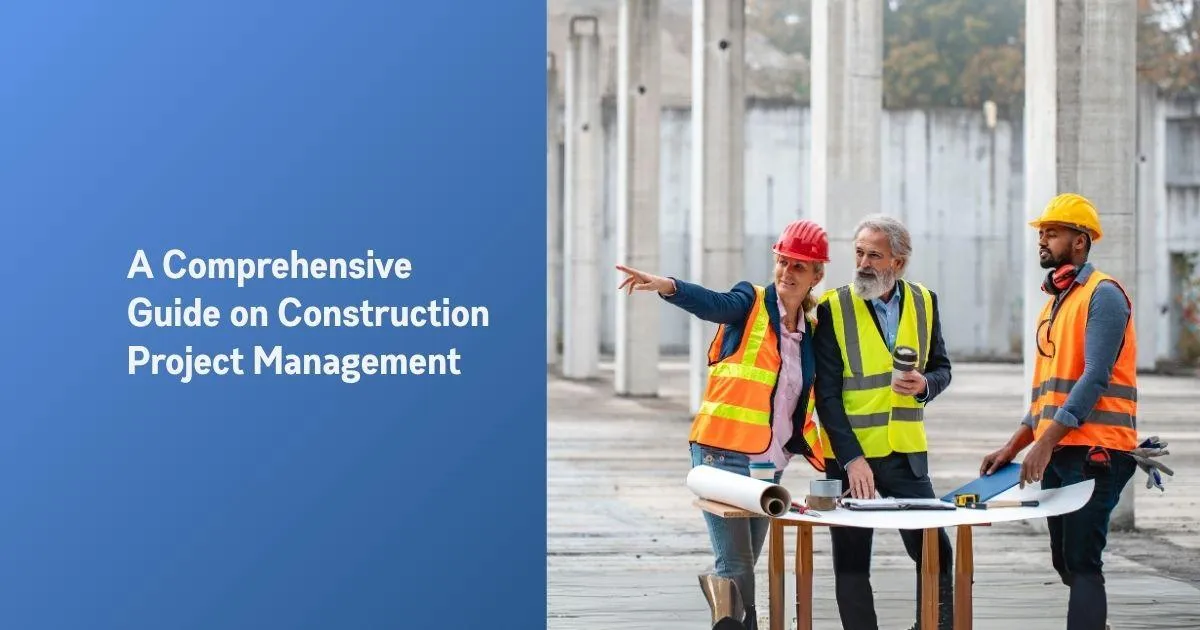
Construction Project Management (A Comprehensive Guide)
Things rarely go exactly as planned on a construction site. One day you’re ahead of schedule, the next you’re short on materials, and somehow the plumber and electrician show up at the same time. That’s where construction project management earns its name by preventing things from turning into a complete mess and the stakes are high.
According to McKinsey, large projects typically take 20% longer to finish than scheduled and run up to 80% over budget. Small projects aren't far behind.
Good construction project management is about real decisions, made under pressure that keep a project moving even when everything is trying to pull it off course. In this article, I'll walk you through everything you need to know about construction project management.
Let's get straight to the topic.
Construction Project Management (A Comprehensive Guide)
What is Construction Project Management?
Key Roles in Construction Project Management
4. Contractors & Subcontractors
Common Project Delivery Methods in Construction Project Management
What Are the 7 Stages of a Construction Project?
Core Areas to Focus on in Construction Project Management
1. Budget Tracking and Cost Control
2. Risk Identification and Mitigation
4. Quality and Compliance Oversight
5. Time Management and Scheduling
Top Construction Project Management Tools & Software
What are the Best Construction Project Management Practices?
Common Challenges in Construction Project Management (And How to Solve Them)
1. Unplanned Changes Slowing Everything Down
2. Poor Coordination Between Teams
3. Delays in Materials and Equipment
4. Missing Legal Approvals or Safety Checks
What is Construction Project Management?
Construction project management is the process of planning, organizing, and handling everything needed to complete a construction job from start to end. It helps ensure the project is completed on time, stays within budget, and meets the quality standards set by the client.
The person in charge, usually called a construction project manager, has a big job. They create timelines, manage budgets, hire the right people, and obtain legal approvals. They must keep everyone from workers to owners on the same page.
It covers all kinds of projects: homes, offices, roads, malls, you name it. Because there are so many moving parts, using tools such as construction project management software and construction project management apps has become a normal part of the job.
Without solid management, even simple projects can face delays, cost more than expected, or fall apart halfway through. That's why project management in construction isn’t optional, it’s essential.
Key Roles in Construction Project Management
Behind every successful build, there's a crew of key players keeping the project on track. Here are the main roles that usually make up a solid construction project management team.
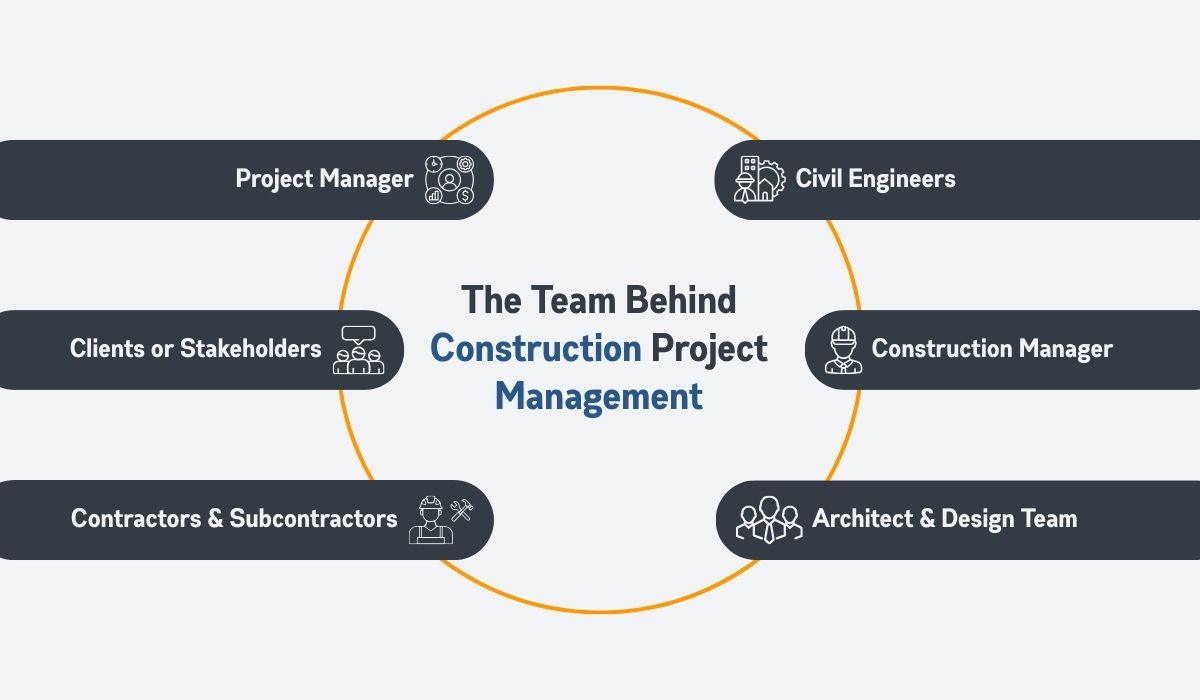
1. Project Manager
The project manager is the lead navigator. They map out every phase, manage schedules, balance costs, and handle communication between everyone involved. Their job is to prevent chaos before it happens. They also rely heavily on construction project management tools to monitor timelines, budgets, and changes in real time.
Still Doing It All Manually? Project Management Automation Is the Upgrade You Need Now
2. Construction Manager
While the project manager focuses on the plan, the construction manager stays grounded. They’re on-site every day and supervise the crew, track progress, and manage the flow of materials. When delays or safety issues arise, they’re the first to respond and adjust the schedule to keep things on track.
3. Architect & Design Team
This team brings the vision to life. From blueprints to 3D models, they create structures that are not only functional but also compliant with codes. Throughout the project, they stay in touch with engineers and contractors to ensure that what’s being built still aligns with the approved designs.
4. Contractors & Subcontractors
Contractors handle the build, but subcontractors bring the details. You’ll find electricians, plumbers, roofers, and dozens of skilled professionals working together under a general contractor. The smoother their coordination is, the fewer delays and reworks there will be. That’s why managing them well is central to any construction project management service.
5. Civil Engineers
Civil engineers review every design to confirm it can be built safely, within budget, and on the selected site. Their involvement reduces the risk of structural failures or code violations later on. They also guide material choices and supervise inspections during key phases of the construction process.
6. Clients or Stakeholders
Often the quietest in the room, clients make the biggest decisions. Be it a real estate investor, a company, or a government body, their approvals shape every phase. Good project managers communicate clearly with them, making sure updates are timely, budgets are justified, and expectations are managed throughout.
👉 The role of project managers is evolving. Here’s what AI means for the future of construction leadership.
Common Project Delivery Methods in Construction Project Management
The way a construction project is delivered matters as much as its blueprint. Choosing the right construction project management delivery method shapes timing, communication, and accountability. The following are the most widely used approaches in the industry nowadays.
Design-Bid-Build (DBB): This is the most traditional method. First, the design is completed. Then, bids are collected from contractors, and finally, the construction begins. It works best when cost control is a priority but the major downside is slower timelines and a higher risk of design changes during execution.
Design-Build: In this approach, the design and construction are handled by a single entity, often a construction project management company or joint team. This streamlines communication and reduces delivery time. It’s ideal when speed matters more than absolute control over design details.
Construction Manager at Risk (CMAR): Here, the owner hires a construction manager during the design phase. The manager provides cost estimates, oversees the design, and commits to delivering the project within a guaranteed maximum price. It's often used for commercial project management due to its balance between speed and quality.
Integrated Project Delivery (IPD): It's a newer, more collaborative model where the owner, contractor, and designer all sign a single contract and share risks and rewards. While not as common, this method is gaining traction for complex projects where transparency and quick problem-solving are essential.
Public-Private Partnership (PPP): It's often used in large infrastructure projects and involves a contract between a public agency and a private-sector entity. The private firm may design, build, finance, and operate the asset for a fixed period.
What Are the 7 Stages of a Construction Project?
You can’t manage what you don’t understand. Every project has a rhythm and knowing the following stages is key.
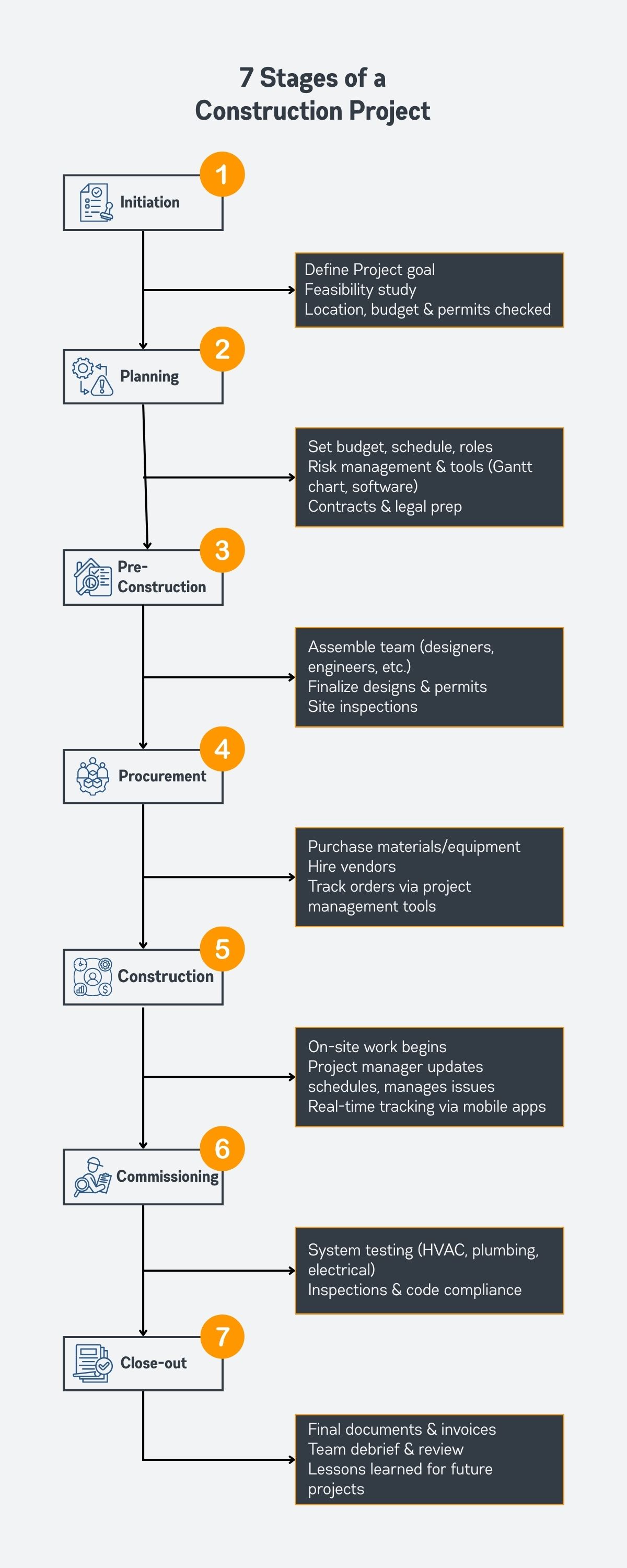
1. Initiation
Every big thing starts with an idea. Here, the project owner or client defines why they want to build something and what they want it to look like. The goal is simple, figure out if it’s feasible and worth it. At this point, a feasibility study is conducted. Is the location right? Is the budget realistic? Will permits be approved?
2. Planning
Once the idea receives the green light, it’s time to plan everything, budget, schedule, team roles, materials, and risk management.
This phase is the backbone of successful construction project management. You’ll use tools like construction project management software or Gantt charts to map out timelines. It’s also when legal matters, contracts, and procurement strategies are determined.
3. Pre-Construction
This is where the team comes together; designers, engineers, consultants, and contractors. You finalize drawings, request permits, and do site testing. It’s like setting the stage for a play. In case anything is unclear at this stage, chaos could happen later.
4. Procurement
This is the shopping phase. The team gathers all the tools, materials, and equipment. Depending on the project, this could involve hiring vendors or placing orders for everything from cement to coffee machines for break rooms.
Poor procurement leads to delays, resulting in extra costs. That's where construction project management software helps track orders and delivery timelines.
5. Construction
Now, the real action begins: excavation, laying the foundation, plumbing, wiring, everything. The project manager is in the thick of it, managing daily site activities, updating schedules, adjusting for weather, and resolving conflicts. Mobile-friendly construction project management app tools allow live updates and quick decisions on-site.
6. Commissioning
The project might appear complete, but it isn’t over yet. This stage involves testing, plumbing, electrical systems, HVAC, and safety inspections. Each aspect must meet codes and regulations. Only after this can you hand over the building.
7. Close-out
This is the final stretch. Documents are gathered, warranties handed over, crews are demobilized, and final invoices are sent. The team conducts a post-project review, discussing what went right, what went wrong, and what can be improved for the future.
This stage often gets overlooked, but it’s crucial for learning and avoiding repeating mistakes in future commercial project management tasks.
Core Areas to Focus on in Construction Project Management
Once you understand the 7 stages, the next question is, what truly demands your attention throughout them? Specific areas, if not managed well, can lead to serious delays, budget issues, or poor outcomes.

1. Budget Tracking and Cost Control
Large construction projects typically take 20% longer to complete and run up to 80% over budget (Mckinsey). Numbers like that indicate real-time cost monitoring isn’t optional, it has become crucial. You can leverage construction project management software that presents budget vs. actual spending at a glance.
2. Risk Identification and Mitigation
Weather, permits, and unexpected site challenges are inevitable. Build a dynamic risk register, assign early warnings, and plan backups. When risks are managed preemptively, you cut delays and costly surprises.
3. Clear Communication
According to the Project Management Institute, poor communication leads to project failure one-third of the time. When teams, clients, and contractors aren’t on the same page, small delays can pile up quickly. A reliable construction project management app keeps everyone aligned by centralizing updates, files, and feedback in one place.
4. Quality and Compliance Oversight
Neglecting quality leads to rework and safety issues. Regular inspections, documented checklists, and adherence to codes keep defects or fines under control. Good construction project management services assist in structure quality reviews throughout every phase.
5. Time Management and Scheduling
Deadlines drive momentum, so align crews, materials, and approvals with a shared timeline. Use tools that highlight the critical path and flag upcoming delays. A construction project management app can alert stakeholders before slip-ups occur.
Top Construction Project Management Tools & Software
You've got the know-how. But what about the right tools to support it? To save you hours of scrolling, here’s a quick comparison of the best construction project management tools.
What are the Best Construction Project Management Practices?
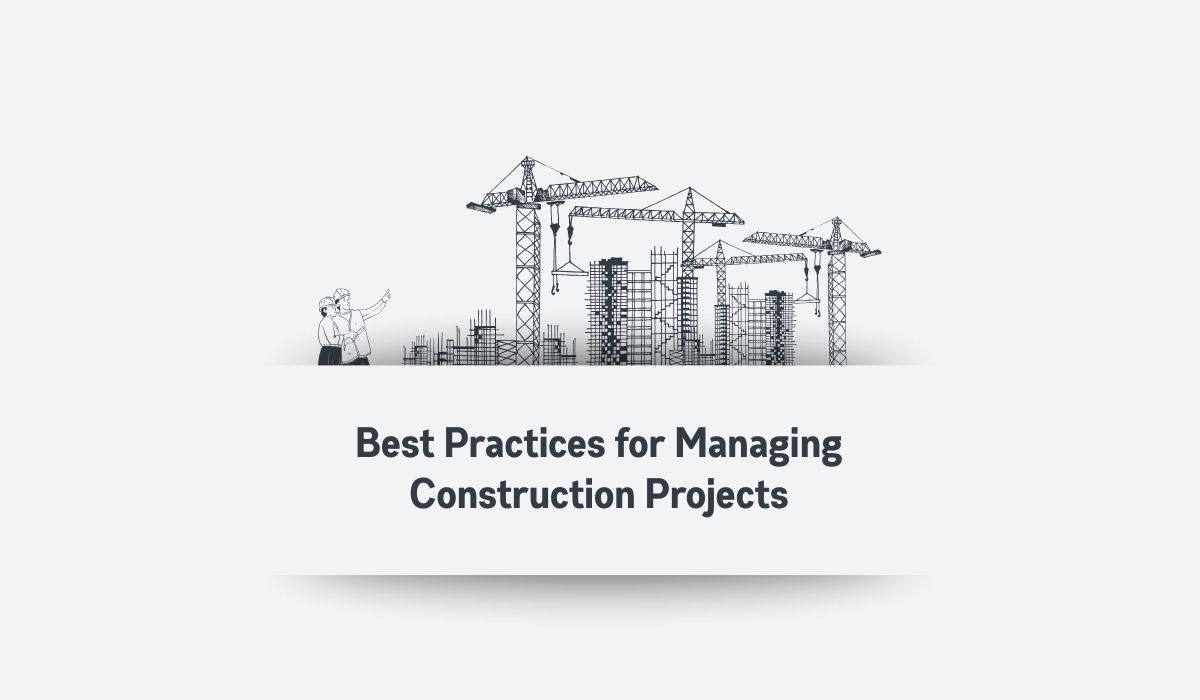
When you have the right tools ready, embedding solid habits ensures they make a difference. Here are the most impactful practices to keep your project on track.
Hold brief daily or weekly check-ins to confirm priorities, spot risks early, and keep everyone aligned on deadlines.
Centralize all documents, plans, permits, and change orders in your construction project management app for instant access and version control.
Involve clients and key stakeholders regularly to prevent scope creep and manage expectations before small changes escalate into big issues.
Maintain a dynamic risk register that’s reviewed at each stage, assign owners, and set mitigation steps so surprises are minimized.
Enforce routine quality inspections with documented checklists; assign clear corrective actions to avoid rework and hidden costs.
Leverage real-time dashboards in your chosen construction project management software to monitor budget versus actual spend and flag overruns immediately.
Provide hands-on training to your crew on any new tools or processes. Technology only helps when people know how to use it.
Track labor productivity metrics and subcontractor performance, using data to adjust schedules or resource allocation before delays stack up.
Celebrate small wins, because recognizing on-time milestones and problem-solving efforts boosts morale and reinforces a culture of accountability.
Common Challenges in Construction Project Management (And How to Solve Them)
Although when everything is well-planned, construction projects rarely go exactly as expected. Delays happen, plans change, and teams encounter unexpected issues. It’s all part of the job.
However, knowing what problems tend to arise can help you prepare better and respond faster. Here are five of the most common challenges in construction project management, along with simple ways to address them.
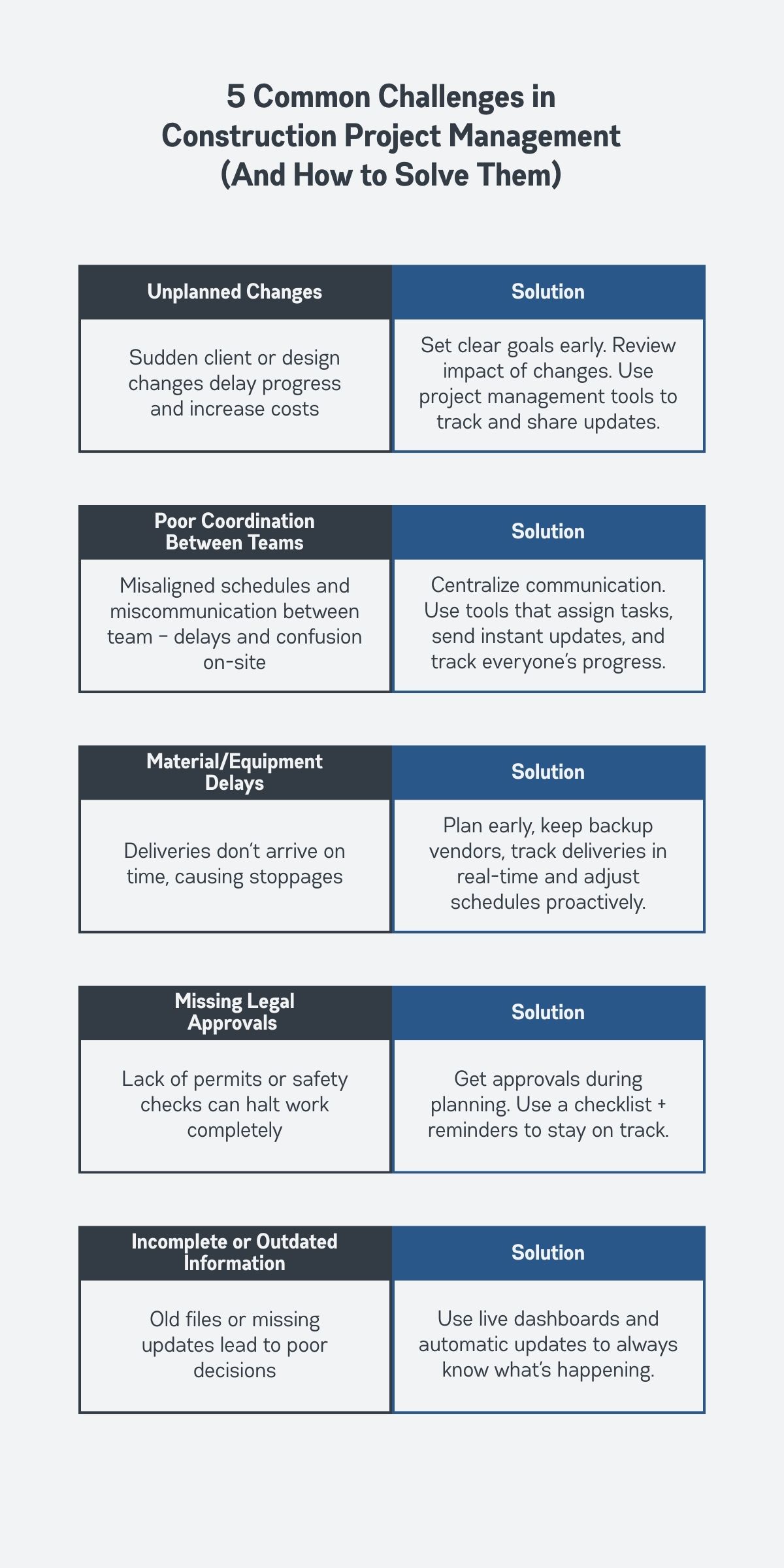
1. Unplanned Changes Slowing Everything Down
Sometimes, a client requests new features after the work has started. Or a small design change leads to more time, more workers, and more materials. These changes are common but if not managed properly, they can cause long delays and additional costs.
What to do?
Make sure the project goals are clearly defined from the beginning. If changes come up, always assess how they will impact your budget and timeline before proceeding. Use a good construction project management app to keep these updates organized and share them with everyone involved.
2. Poor Coordination Between Teams
This is also a challenge. When people aren’t on the same page, it leads to confusion. For example, the concrete team shows up, but the formwork isn’t ready yet. Or materials arrive late because no one followed up. This kind of miscommunication can easily disrupt your entire construction workflow.
What to do?
Keep all updates, schedules, and tasks in one accessible location for everyone. Use tools that help you assign tasks clearly, send updates instantly, and track progress across the full team from engineers to on-site workers.
3. Delays in Materials and Equipment
Sometimes, the materials you need arrive late. Or maybe the supplier can’t deliver what was promised. Such delays create gaps in the schedule and force other work to stop.
What to do?
Plan your purchases early, and always have a backup supplier if possible. Use real-time project tracking tools to monitor deliveries and adjust the work schedule if needed. The earlier you identify an issue, the easier it is to fix.
4. Missing Legal Approvals or Safety Checks
If the project doesn’t adhere to safety rules or meet local building codes, you may be forced to stop work until everything is resolved. This can cause major setbacks.
What to do?
Make sure all approvals and permits are secured during the planning phase. Keep a checklist for each phase to stay on track. A project management tool with reminders can help you stay ahead of deadlines and inspections.
5. Incomplete or Outdated Information
If you're working with old spreadsheets or missing updates, it’s challenging to know what’s actually happening on-site. This makes it difficult to resolve problems or plan ahead.
What to do?
Use tools that automatically update and provide a clear overview of every project aspect. Dashboards and real-time reports help you make better decisions without wasting time.
Final Word from Purely Startup
Managing a construction project is less about perfection and more about preparation. You can't control every variable, but with the right tools, practices, and mindset, you can lead confidently from blueprint to ribbon-cutting.
Moreover, this isn’t limited to construction giants; small residential builders can achieve big wins too by using the right construction project management tools. Need help finding the right construction project management services for your team? Book a consultation call with us. We’ll guide you through it.


